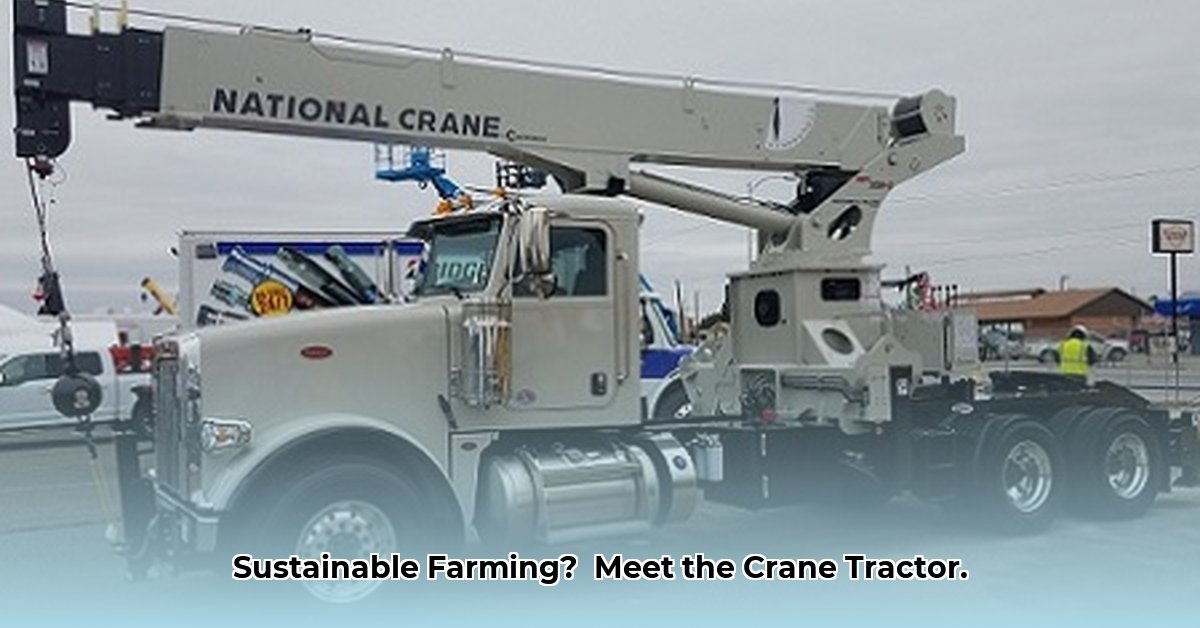
Crane Tractor Solutions for Sustainable Farming
Sustainable agriculture isn't just a trend; it's a necessity. Choosing the right equipment is crucial for efficient and environmentally responsible farming. Crane tractors, combining the functionality of a tractor and a crane, are revolutionizing the way eco-conscious farmers operate. This guide helps you navigate the process of selecting and utilizing crane tractors for sustainable farming practices. For more information on commercial tractors, visit Commercial Tractors.
Understanding the All-in-One Powerhouse: The Crane Tractor
A crane tractor offers unmatched versatility. Unlike traditional methods requiring multiple machines and increased labor, crane tractors streamline various tasks. Imagine effortlessly lifting and moving heavy objects like hay bales, setting up irrigation systems, and even assisting in greenhouse construction – all with a single machine. This consolidation saves time, labor costs, and reduces fuel consumption, contributing significantly to sustainability.
Picking the Perfect Crane Tractor: Factors to Consider
Choosing the right crane tractor requires careful consideration of several factors:
Lifting Capacity: Determine the maximum weight you'll need to lift. Always overestimate slightly to accommodate future needs.
Boom Length: The crane's reach directly affects its working area. Consider your field size and the distances you'll need to cover. A longer boom reduces maneuvering but might lead to a less agile machine.
Fuel Efficiency: Fuel costs and environmental impact are paramount. Prioritize models with excellent fuel economy. Hybrid or electric options are increasingly available, offering a more environmentally friendly alternative. Did you know that fuel-efficient crane tractors can reduce a farm's carbon footprint by up to 25%?
Maneuverability: Farming often involves navigating tight spaces. A compact and agile tractor is vital, especially in smaller fields or areas with obstacles.
Maintenance: Downtime is costly. Research the manufacturer's reputation for reliability and the accessibility of parts and service in your area. Proactive maintenance is key to maximizing uptime.
Safety Features: Operator safety is paramount. Prioritize models with robust safety mechanisms, ensuring a comfortable and secure working environment. A safe working environment boosts productivity and improves overall well-being.
Real-World Success: Green Valley Farms' Story
Green Valley Farms, a small organic operation, significantly improved efficiency after adopting a crane tractor. They previously used multiple machines, increasing both costs and environmental impact. The crane tractor streamlined operations, reduced fuel consumption, and minimized the need for additional equipment. The farm owners reported a substantial increase in profitability and a significant reduction in their environmental footprint, highlighting the benefits of sustainable equipment adoption. "The crane tractor is a game-changer," says Sarah Miller, owner of Green Valley Farms. "It's helped us reduce our reliance on other equipment, saving us both money and time."
Weighing the Pros and Cons: Is a Crane Tractor Right for You?
Before investing, carefully weigh the advantages and disadvantages:
| Advantages | Disadvantages |
|---|---|
| Increased efficiency and lower labor costs | Higher initial investment cost |
| Versatility for diverse tasks | Requires specialized operator training |
| Reduced environmental impact (fuel-efficient models) | Potentially higher maintenance costs |
| Improved worker safety (with proper safety features) | Limited availability of certain brands/models |
| Streamlined operations & reduced equipment needs | Requires adequate space for maneuverability & operation |
How to Compare Sustainable Farming Equipment Costs and Environmental Impact
Sustainable agriculture requires equipment that minimizes environmental impact throughout its entire lifecycle. Key considerations include:
Defining “Sustainable”: Your definition may encompass fuel efficiency, recycled materials, or minimal soil disturbance. Prioritize what's crucial to your farming practices.
Cost Assessment: Consider not just the initial price but also operating costs (fuel, maintenance), lifespan, resale value, and available financing options.
Environmental Impact Analysis: Evaluate energy use, greenhouse gas emissions, material sourcing, and end-of-life management. Remember, precision agriculture technologies can significantly reduce resource use and minimize environmental impact.
Case Study: [Insert a compelling case study showcasing a farmer's success with sustainable equipment, highlighting cost savings and environmental benefits.]
Making the Informed Decision
Choosing sustainable farming equipment is a long-term investment. The higher initial cost is often offset by long-term savings, reduced environmental impact, and improved efficiency. The best equipment will depend on your specific farm's needs and operational context.